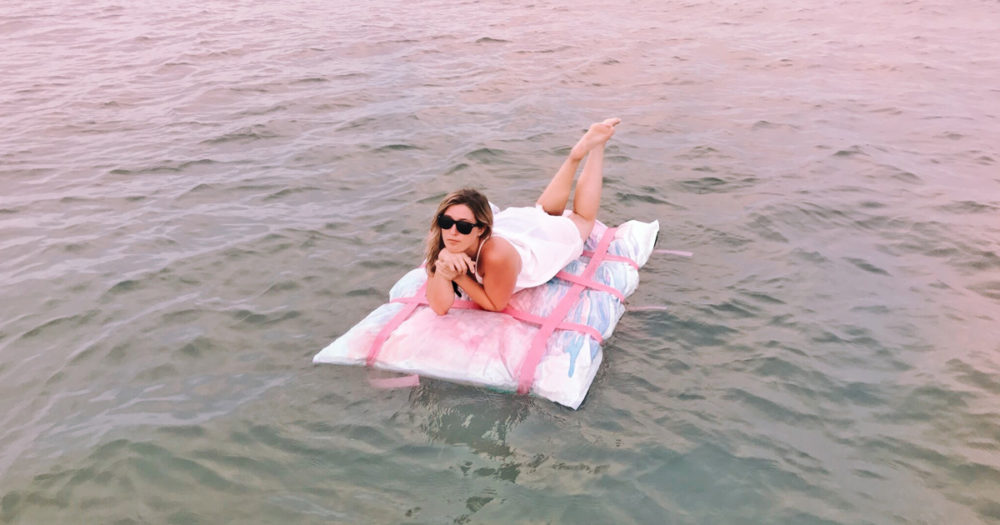Wouldn’t it be bizarre to explore how an artist would go about preparing their artwork for climate change? In a natural disaster scenario, no one says “Grab the passports and the dog… and the Modigliani!” So, the works presumably will have to fend for themselves. This thought launched my most recent series of work. Now, a year and a half later, I will be floating down the Potomac River on top of one of my “climate change ready” paintings as both a demonstration of its capabilities and a symbolic gesture to the government establishments I feel are ignoring the problem.
I’ve always believed that art and science strengthen each other when combined. In an era of half-truths, full-lies, and intentionally blurred lines, the relationship between art and science is more important than ever. Science provides us with the evidence, but I believe art can plant the message deep enough emotionally to sprout into useful action.
As a Miami native, I’ve decided to currently focus on rising sea levels since it is an issue that I have experienced first-hand. The streets of Miami and Miami Beach regularly flood during high tides, a change from years past. As an April edition of Business Insider explained, “Because of ocean currents and Miami’s location, sea levels are rising in and around the city and Miami Beach faster than in most of the world.” However, Miami isn’t the only city at risk. According to the National Ocean Service of NOAA, “In the United States, almost 40 percent of the population lives in relatively high-population-density coastal areas, where sea level plays a role in flooding, shoreline erosion, and hazards from storms. Globally, eight of the world’s 10 largest cities are near a coast.”
The idea of climate change isn’t anything new. Before Al Gore and Leonardo Di Caprio, there were others who warned us of our trajectory. It was in 1824 that French physicist Joseph Fourier first observed and wrote of the “greenhouse effect” of the Earth. He was followed by Swedish chemist Svante Arrhenius in 1896 who concluded that the huge influx of coal burning from the industrial revolution would greatly augment the greenhouse effect. By the 1960s, it was becoming increasingly clear that human induced carbon dioxide was warming the atmosphere at a rate faster than ever experienced in recorded history. As stated in the Union of Concerned Scientists’s article Global Warming Science, “Over the past 130 years, the global average temperature has increased 1.5 degrees Fahrenheit, with more than half of that increase occurring over only the past 35 years… [and] …scientists have detailed records of past CO2 levels from ice core studies, which show that CO2 levels are higher today than at least any point in the last 800,000 years ago.”
What’s most alarming to me is that despite so many years of mounting research and warnings, we’ve done so little to solve the problem. There is a general sense of apathy when speaking to the general public about climate change. “Yes, it’s a problem, but what can I personally do about it?” they ask with a shrug. Photographs of starving polar bears and melting icecaps just aren’t jarring enough to a public exposed to far worse, albeit fictional, scenes on television and in movies. I hope to sneak through this wall of apathy that has currently built up around the issue, and I’ve found that my Trojan horse is a sense of humor. Humor catches people off guard, and I can often find myself in conversations with people who otherwise wouldn’t have been open to the topic.
When I began researching various ways to make my paintings “climate change ready,” one place I looked was in the tomes of art history, and I found that creating paintings has always involved planning for their long term stability. Artists of the past learned how to layer their oils in such a way as to minimize future cracking. They created new pigments that were less volatile and held their original color far longer. Knives were hung beneath portraits so that should a home catch fire, the owner could quickly cut the painting from its heavy frame and toss it out the window to safety. With that history in mind, I decided to follow the long evolutionary lineage of pre-emptive art preservation, but today’s issues call for new solutions. I consulted with an expert in the field of art conservation, and through a process of trial and error, I began experimenting. I learned to weave my own canvas and embed buoys and other found flotation devices into the fabric of my paintings. I have tried approaches as simple and playful as wrapping existing paintings in common pool noodles to more serious and complex waterproof paintings made of synthetic sailcloth & marine foam.
People generally laugh and engage when I point out that my artwork is designed to survive rising sea levels. As for my own amusement, I imagine some day in the future, an art collector will be safely sitting on top of their floating artwork exclaiming “Thank goodness we bought a Noel Kassewitz!”
Kassewitz plans to float down the Potomac during the last week of August, weather permitting. For more information on her art and when and where Kassewitz will be floating next, you can visit her website: www.noelkassewitz.com or follow her on social media via Instagram @noelkassewitzart.

